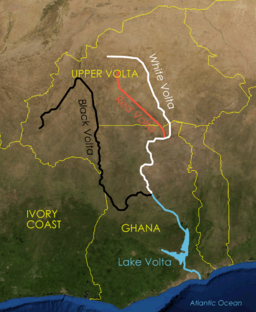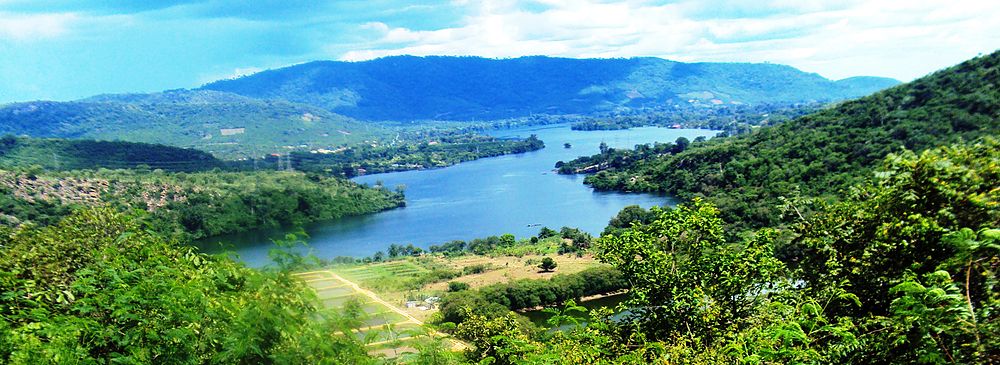geo.wikisort.org - Reservoir
Lake Volta, the largest artificial reservoir in the world based on surface area, is contained behind the Akosombo Dam which generates a substantial amount of Ghana's electricity. It is completely within the country of Ghana and has a surface area of 8,502 square kilometres (3,282+1⁄2 sq mi).[1] It extends from Akosombo in the south to the northern part of the country.[2][3]
| Lake Volta | |
|---|---|
 Space Imaging view of Lake Volta from the International Space Station in Space, by NASA. | |
 Lake Volta | |
 Lake Volta in Ghana | |
| Location | Ghana, West Africa |
| Coordinates | 6°30′N 0°0′E |
| Lake type | Reservoir |
| Primary inflows | White Volta River Black Volta River |
| Primary outflows | Volta River |
| Catchment area | 385,180 km2 (148,720 sq mi) |
| Basin countries | Ghana |
| Surface area | 8,502 km2 (3,283 sq mi) |
| Average depth | 18.8 m (61 ft 8 in) |
| Max. depth | 75 m (246 ft) |
| Water volume | 148 km3 (32.6 × 1012 gallons) |
| Shore length1 | 4,800 kilometres (2,980 mi) |
| Surface elevation | 85 m (279 ft) |
| 1 Shore length is not a well-defined measure. | |
Geography
Lake Volta lies along the Prime meridian, and just six degrees of latitude north of the Equator. The lake's northernmost point is close to the town of Yapei, and its southernmost extreme is at the Akosombo Dam, 520 km (320 mi) downstream from Yapei. Akosombo Dam holds back both the White Volta River and the Black Volta River, which formerly converged where the middle of the reservoir now lies, to form the single Volta River. The present Volta River flows from the outlets of the dam's powerhouse and spillways to the Atlantic Ocean in southern Ghana.
The main islands within the lake are Dodi, Dwarf, and Kporve.[4] Digya National Park lies on part of the lake's western shore.
History
The lake was formed by the Akosombo Dam, which was originally conceived by the geologist Albert Ernest Kitson in 1915, but whose construction only began in 1961 with completion in 1965. Because of the formation of Lake Volta, about 78,000 people were relocated[5] to new towns and villages, along with 200,000 animals belonging to them. About 120 buildings were destroyed, not including small residences, and over 7,800 km2 (3,000 sq mi) of territory were flooded.
Economy
The Akosombo Dam produces 912 MW of electricity for the country, as well as for export to Togo, Benin, and other nearby countries to earn foreign exchange.[1] Lake Volta is also important for transportation, providing a waterway for both ferries and cargo watercraft. Since the huge lake lies in a tropical area, the water remains warm year-round naturally. Given good management, Lake Volta is the location of a vast population of fish and large fisheries.
The lake also attracts tourism, and tourist cruises visit the island of Dodi.[4]
Recent developments include a large-scale enterprise to harvest submerged timber from the flooded forests under Lake Volta. This project harvests high-value tropical hardwood without requiring additional logging or destruction of existing forest and, according to Wayne Dunn, "could generate the largest source of environmentally sustainable natural tropical hardwood in the world."[6] The Ghanaian-owned company Underwater Forest Resources has committed itself to making this lumber available in the global market, while Flooring Solutions Ghana have become the suppliers of hardwood floors, using the rare wood from the Lake.[citation needed] In addition to generating foreign currency for the region and reducing the dependence of locals on fishing as a primary economic activity, the removal of submerged trees is improving navigation on the lake and increasing safety.[6]
An estimated 7,000 to 10,000 children work in the fishing industry on Lake Volta. The nature of their employment has been described as slavery in The Guardian[7] and by the CNN Freedom Project. This has been described as sensationalism by Betty Mensah and the academic Samuel Okyere since many of the children and youth whose wages are given upfront to their parents grow up to become self-sufficient fishermen in adulthood who in turn hire children themselves and could therefore also be characterized as apprentices. They conclude, that many children may suffer under exploitative work but are not enslaved.[8]
Photos
- A ferry on Lake Volta
- Photograph of Lake Volta
- Akosombo Port's signage
- Trees in Lake Volta
- Dock of Dodi Island with Dodi Princess
See also
- Lake Kariba, the world's largest reservoir by volume
References
- "Lake Volta | lake, Ghana". Encyclopedia Britannica. Retrieved 2021-02-06.
- "Lake Volta, Ghana". Visible Earth. NASA. 7 April 2002. Retrieved 7 March 2018.
- "Largest, Tallest, Biggest, Shortest". McqsPoint. McqsPoint. Retrieved 9 February 2018.
- "Dodi Island cruises". secureserver.net. Archived from the original on 2010-10-31.
- "Lake Volta | lake, Ghana".
- "Harvesting an Underwater Forest". Archived from the original on March 4, 2012. Retrieved 28 May 2011.
{{cite web}}: CS1 maint: unfit URL (link) - "Sons for Sale". www.theguardian.com. 22 March 2007.
- Okyere, Samuel (18 March 2019). "How CNN reported on 'child slaves' who were not really enslaved". AlJazeera. Retrieved 30 July 2019.
External links
- Lake Volta & Akosombo on Ghanaweb.com
- Volta Lake, International Lake Environment Committee Web site
- Gold exploration in the Volta region — Objective Capital Africa Resources Investment Conference (video)
- Lake Volta — more information on Ghana-Net.com
На других языках
[de] Volta-Stausee
Der Volta-Stausee wird vom Akosombo-Staudamm bei der Kleinstadt Akosombo im südöstlichen Ghana (Westafrika) aufgestaut. Er ist mit seiner Fläche von 8502 km² der größte Stausee der Erde, der vollständig von Menschen geschaffen wurde. Der Staudamm wurde ungefähr 100 km nordöstlich der Hauptstadt Accra errichtet. Neben einigen anderen Zuflüssen staut er insbesondere den Volta mit seinen drei Quellflüssen (Schwarzer, Weißer und Roter Volta) auf.- [en] Lake Volta
[es] Lago Volta
El lago Volta es el embalse con mayor superficie del mundo. Se encuentra en Ghana y ocupa cerca de 8.502 km², es decir el 3,3% de la superficie nacional. El límite septentrional es la ciudad de Yapei y el meridional la presa de Akosombo. De un extremo a otro hay 520 km. Tiene una profundidad máxima de 75 m y un volumen de 148 km³.[1][fr] Lac Volta
Le lac Volta est un réservoir d’eau douce sur le fleuve Volta au Ghana en Afrique.[it] Volta (lago)
Il lago Volta è il maggiore lago artificiale al mondo, con circa 8502 km² di superficie e 148 km³ di acqua immagazzinata.[ru] Вольта (водохранилище)
Во́льта (Акосомба; англ. Volta, Akosomba)[1][3] — крупнейшее по площади (площадь поверхности — 8480 км²) русловое водохранилище в мире. Находится на реке Вольта в Гане[1].Другой контент может иметь иную лицензию. Перед использованием материалов сайта WikiSort.org внимательно изучите правила лицензирования конкретных элементов наполнения сайта.
WikiSort.org - проект по пересортировке и дополнению контента Википедии






